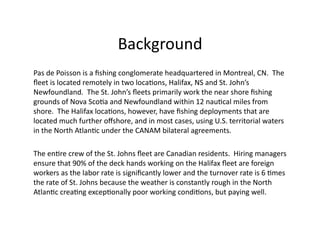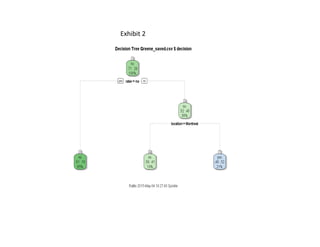Predictive Modeling using R
- 1. Background ╠² Pas ╠²de ╠²Poisson ╠²is ╠²a ╠²’¼üshing ╠²conglomerate ╠²headquartered ╠²in ╠²Montreal, ╠²CN. ╠² ╠²The ╠² ’¼éeet ╠²is ╠²located ╠²remotely ╠²in ╠²two ╠²loca?ons, ╠²Halifax, ╠²NS ╠²and ╠²St. ╠²JohnŌĆÖs ╠² Newfoundland. ╠² ╠²The ╠²St. ╠²JohnŌĆÖs ╠²’¼éeets ╠²primarily ╠²work ╠²the ╠²near ╠²shore ╠²’¼üshing ╠² grounds ╠²of ╠²Nova ╠²Sco?a ╠²and ╠²Newfoundland ╠²within ╠²12 ╠²nau?cal ╠²miles ╠²from ╠² shore. ╠² ╠²The ╠²Halifax ╠²loca?ons, ╠²however, ╠²have ╠²’¼üshing ╠²deployments ╠²that ╠²are ╠² located ╠²much ╠²further ╠²o’¼Ćshore, ╠²and ╠²in ╠²most ╠²cases, ╠²using ╠²U.S. ╠²territorial ╠²waters ╠² in ╠²the ╠²North ╠²Atlan?c ╠²under ╠²the ╠²CANAM ╠²bilateral ╠²agreements. ╠² ╠² ╠² The ╠²en?re ╠²crew ╠²of ╠²the ╠²St. ╠²Johns ╠²’¼éeet ╠²are ╠²Canadian ╠²residents. ╠² ╠²Hiring ╠²managers ╠² ensure ╠²that ╠²90% ╠²of ╠²the ╠²deck ╠²hands ╠²working ╠²on ╠²the ╠²Halifax ╠²’¼éeet ╠²are ╠²foreign ╠² workers ╠²as ╠²the ╠²labor ╠²rate ╠²is ╠²signi’¼ücantly ╠²lower ╠²and ╠²the ╠²turnover ╠²rate ╠²is ╠²6 ╠²?mes ╠² the ╠²rate ╠²of ╠²St. ╠²Johns ╠²because ╠²the ╠²weather ╠²is ╠²constantly ╠²rough ╠²in ╠²the ╠²North ╠² Atlan?c ╠²crea?ng ╠²excep?onally ╠²poor ╠²working ╠²condi?ons, ╠²but ╠²paying ╠²well. ╠²
- 2. Execu?ve ╠²Summary ╠² The ╠²hiring ╠²managers ╠²of ╠²Pas ╠²de ╠²Poissen ╠²sought ╠²the ╠²guidance ╠²of ╠²a ╠²consul?ng ╠² ’¼ürm ╠²to ╠²determine ╠²which ╠²of ╠²the ╠²na?onality ╠²of ╠²the ╠²foreign ╠²work ╠²force, ╠²entering ╠² Canada, ╠²would ╠²have ╠²the ╠²highest ╠²probability ╠²that ╠²a ╠²judge ╠²would ╠²approve ╠²their ╠² appeal ╠²to ╠²remain, ╠²and ╠²subsequently ╠²be ╠²employable ╠²in ╠²the ╠²country. ╠² ╠² ╠² Establishing ╠²a ╠²model ╠²to ╠²best ╠²determine ╠²which ╠²candidates ╠²to ╠²hire ╠²provided ╠² excep?onal ╠²cost ╠²saving ╠²opportuni?es. ╠² ╠²In ╠²the ╠²past, ╠²if ╠²the ╠²company ╠²was ╠² informed ╠²that ╠²one ╠²of ╠²their ╠²new ╠²foreign ╠²na?onal ╠²workers ╠²was ╠²not ╠²granted ╠²an ╠² appeal, ╠²and ╠²was ╠²ac?vely ╠²on ╠²a ╠²’¼üshing ╠²deployment, ╠²at ╠²?mes ╠²las?ng ╠²for ╠²over ╠²45 ╠² days, ╠²the ╠²trawler ╠²was ╠²forced ╠²to ╠²return ╠²to ╠²port. ╠² ╠²A ╠²vessel ╠²having ╠²to ╠²return ╠² equated ╠²to ╠²missed ╠²opportunis?c ╠²revenue, ╠²as ╠²it ╠²could ╠²no ╠²longer ╠²’¼üsh, ╠²and ╠² unexpected ╠²fuel ╠²expenses ╠²for ╠²return ╠²transit. ╠² ╠²Furthermore, ╠²the ╠²penalty ╠²for ╠² knowing ╠²employing ╠²an ╠²illegal ╠²foreign ╠²worker ╠²was ╠²harsh ╠²from ╠²both ╠²the ╠² Canadian ╠²and ╠²U.S ╠²’¼üsheries ╠²enforcement ╠²agencies. ╠²
- 3. Data ╠²Integrity ╠² ŌĆóŌĆ» Source: ╠²Ra[le ╠²Library ╠² ŌĆóŌĆ» Name: ╠²ŌĆ£Green: ╠²Refugee ╠²AppealŌĆØ ╠² ŌĆóŌĆ» ŌĆ£CleaningŌĆØ ╠²steps ╠² ŌĆóŌĆ» Used ╠²transform ╠²tag ╠²to ╠²remove ╠²missing ╠²and ╠²ignored ╠²data ╠²a`er ╠² comparing ╠²the ╠²original ╠²and ╠²ŌĆ£cleanedŌĆØ ╠²OOB ╠²error ╠²rates. ╠² ╠² Addi?onally, ╠²the ╠²categorical ╠²data ╠²ŌĆ£judgesŌĆØ ╠²was ╠²deemed ╠²to ╠²be ╠² sta?s?cally ╠²insigni’¼ücant ╠²for ╠²our ╠²purposes, ╠²hence ╠²it ╠²was ╠²omi[ed ╠² thus ╠²increasing ╠²the ╠²integrity ╠²of ╠²the ╠²the ╠²dataset. ╠² ŌĆóŌĆ» Steps: ╠² ╠²In ╠²order ╠²to ╠²ful’¼üll ╠²the ╠²hiring ╠²strategy ╠²we ╠²targeted ╠²informa?on, ╠²from ╠² the ╠²data ╠²(using ╠²ra[le, ╠²R ╠²and ╠²excel), ╠²that ╠²would ╠²serve ╠²to ╠²determine ╠²the ╠² informa?on ╠²necessary ╠²to ╠²depict ╠²future ╠²hires ╠²based ╠²on ╠²the ╠²probability ╠²to ╠² determine ╠²an ╠²approved ╠²appeal. ╠² ╠²
- 4. Forest ╠²Model ╠² !ŌĆ» Imported ╠²the ╠²data ╠²and ╠²Rescaled ╠² ╠² !ŌĆ» Created ╠²a ╠²Forest ╠²model ╠²with ╠²default ╠²op?ons ╠² !ŌĆ» OOB ╠²error ╠²=30.62% ╠², ╠²Type ╠²1= ╠²16.12 ╠²% ╠²and ╠²Type ╠²2 ╠²=65.5 ╠²%error, ╠²AUC ╠²= ╠²0.644 ╠² !ŌĆ» Our ╠²business ╠²requires ╠²more ╠²focus ╠²on ╠²Type ╠²1 ╠²error ╠²rather ╠²than ╠²Type ╠²2 ╠²error ╠² !ŌĆ» Checked ╠²the ╠²trend ╠²of ╠²errors ╠²and ╠²importance ╠² !ŌĆ» Created ╠²a ╠²sample ╠²of ╠²35,35 ╠² !ŌĆ» OOB ╠²es?mate ╠²of ╠² ╠²error ╠²rate: ╠²35.83%, ╠²Type ╠²1 ╠²error ╠²rate ╠²= ╠²35.02%, ╠²Type ╠²2 ╠²error ╠²rate ╠²= ╠² ╠² 37.77%, ╠²AUC ╠²= ╠²0.653 ╠² !ŌĆ» Error ╠²rate ╠²increased, ╠²Type ╠²1 ╠²increased-┬ŁŌĆÉ ╠²not ╠²good ╠² !ŌĆ» No ╠²major ╠²change, ╠²although ╠²type ╠²2 ╠²decreased ╠² !ŌĆ» Look ╠²for ╠²a ╠²be[er ╠²one. ╠²Prune ╠²the ╠²trees ╠²at ╠²minimum ╠²complexity ╠² !ŌĆ» Here ╠²tree ╠²= ╠²421 ╠²and ╠²complexity ╠²= ╠²0.2913 ╠² !ŌĆ» Now, ╠²OOB ╠²es?mate ╠²of ╠² ╠²error ╠²rate: ╠²29.32% ╠², ╠²AUC ╠²= ╠²0.646, ╠²Type ╠²1 ╠²error ╠²= ╠²14.28571%, ╠² Type ╠²2 ╠²error= ╠²65.55% ╠² ╠² !ŌĆ» Type ╠²2 ╠²is ╠²s?ll ╠²large ╠²but ╠²we ╠²are ╠²not ╠²much ╠²concerned ╠²about ╠²that. ╠² !ŌĆ» Best ╠²model ╠²so ╠²far ╠²
- 5. Forest ╠²Model ╠² !ŌĆ» Create ╠²Importance ╠²level ╠²of ╠²Type ╠²1, ╠²Type ╠²2 ╠²error ╠²rate ╠²by ╠²sampling ╠²data ╠²(35,35) ╠² !ŌĆ» randomForest(formula ╠²= ╠²IMO_decision ╠²~ ╠²., ╠²data ╠²= ╠²crs$dataset[crs$sample, ╠² c(crs$input, ╠²crs$target)],ntree ╠²= ╠²421, ╠²mtry ╠²= ╠²5, ╠²sampsize ╠²= ╠²c(35, ╠²35), ╠² importance ╠²= ╠²TRUE, ╠²replace ╠²= ╠²FALSE, ╠²na.ac?on ╠²= ╠²na.rough’¼üx) ╠² !ŌĆ» ╠²OOB ╠²es?mate ╠²of ╠² ╠²error ╠²rate: ╠²36.48%, ╠²Type ╠²1 ╠²error ╠²rate ╠²= ╠²36.4 ╠²%, ╠²Type ╠²2 ╠²error ╠² rate ╠²= ╠²36.6% ╠² !ŌĆ» OOB ╠²increased ╠². ╠²Type ╠²1 ╠²increased ╠²as ╠²expected ╠². ╠²Not ╠²a ╠²good ╠²solu?on ╠² ╠² ╠² !ŌĆ» Our ╠²Best ╠²Solu?on ╠²so ╠²far ╠²is ╠² ╠² ╠² !ŌĆ» 95% ╠²CI: ╠²0.5462-┬ŁŌĆÉ0.6554 ╠²(DeLong) ╠² ╠² !ŌĆ» OOB ╠²es?mate ╠²of ╠² ╠²error ╠²rate: ╠²29.32%, ╠²Type ╠²1 ╠²error ╠²rate ╠²= ╠²14.28%, ╠²Type ╠²2 ╠²error ╠² rate ╠²= ╠²65.6 ╠²%. ╠² !ŌĆ» Run ╠²the ╠²evalua?on ╠²on ╠²the ╠²test ╠²data ╠²set ╠²to ╠²get ╠²the ╠²’¼ünal ╠²result. ╠² ╠² ╠² ╠² ╠² ╠²
- 6. Final ╠²Confusion ╠²Matrix-┬ŁŌĆÉ ╠²Forest ╠²Model ╠²
- 7. Boos?ng ╠²Model ╠² ŌĆóŌĆ» Run ╠²the ╠²Boos?ng ╠²model ╠²with ╠²default ╠²op?ons ╠² ŌĆóŌĆ» OOB ╠²es?mate ╠²of ╠² ╠²error ╠²rate: ╠²21.8% ╠² ŌĆóŌĆ» Type ╠²1 ╠²error ╠²rate ╠²is ╠²6.9%, ╠²Type ╠²2 ╠²error ╠²rate ╠²is ╠²61.1 ╠²%. ╠²Look ╠²for ╠²error ╠²trends ╠²and ╠²importance ╠²of ╠²variables. ╠² Analysis-┬ŁŌĆÉ ╠²Success ╠²and ╠²language ╠²are ╠²major ╠²predictors ╠² ŌĆóŌĆ» Training ╠²Error ╠²is ╠²high ╠²ini?ally, ╠²down ╠²warding ╠²as ╠²number ╠²of ╠²itera?ons ╠²increase. ╠² ŌĆóŌĆ» Try ╠²to ╠²look ╠²at ╠²the ╠²point ╠²where ╠²error ╠²graph ╠²becomes ╠²constant. ╠² ŌĆóŌĆ» 1ŌĆÖs ╠²as ╠²shown ╠²in ╠²the ╠²graph ╠²depict ╠²the ╠²trend, ╠²but ╠²the ╠²trend ╠²again ╠²is ╠²changing ╠²beyond ╠²itera?on ╠²50. ╠² ŌĆóŌĆ» Build ╠²more ╠²itera?ons ╠²to ╠²’¼ügure ╠²out ╠²the ╠²trend ╠²and ╠²the ╠²point ╠²a`er ╠²which ╠²error ╠²rate ╠²is ╠²constant. ╠² ŌĆóŌĆ» Analysis-┬ŁŌĆÉ ╠²Success ╠²and ╠²language ╠²are ╠²major ╠²predictors ╠² ŌĆóŌĆ» Build ╠²the ╠²model ╠²with ╠²itera?on ╠²= ╠²200 ╠² ŌĆóŌĆ» Analysis-┬ŁŌĆÉ: ╠²The ╠²trend ╠²seems ╠²clear. ╠²A`er ╠²140 ╠²itera?ons, ╠²the ╠²error ╠²rate ╠²graph ╠²becomes ╠²constant. ╠² ŌĆóŌĆ» Set ╠²the ╠²itera?ons ╠²to ╠²140 ╠²and ╠²con?nue ╠²the ╠²boos?ng ╠²model. ╠² ŌĆóŌĆ» Analysis-┬ŁŌĆÉ: ╠²OOB ╠²error ╠²is ╠²21.2 ╠²% ╠²but ╠²Type ╠² ╠²2 ╠²errors ╠²are ╠²very ╠²large. ╠² ╠² ŌĆóŌĆ» AUC ╠²=68%. ╠²S?ll ╠²room ╠²for ╠²improvement. ╠²Set ╠²the ╠²importance ╠²matrix. ╠²We ╠²need ╠²less ╠²Type ╠²2 ╠²error. ╠² ŌĆóŌĆ» Call: ╠² ada(IMO_decision ╠² ~ ╠² ., ╠² data ╠² = ╠² crs$dataset[crs$train, ╠² c(crs$input, ╠² ╠² crs$target)], ╠² control ╠² = ╠² rpart.control(maxdepth ╠²= ╠²30, ╠²cp ╠²= ╠²0.01, ╠² ╠²minsplit ╠²= ╠²20, ╠²xval ╠²= ╠²10), ╠²parms ╠²= ╠²list(split ╠²= ╠²"informa?on", ╠² ╠²loss ╠²= ╠² matrix(c(0, ╠²1, ╠²1.5, ╠²0), ╠²byrow ╠²= ╠²TRUE, ╠²nrow ╠²= ╠²2)), ╠²iter ╠²= ╠²140) ╠² ╠²
- 8. Final ╠²Confusion ╠²Matrix-┬ŁŌĆÉ ╠²Boos?ng ╠² Model ╠² ŌĆóŌĆ» ╠² ╠² ╠² ╠² ╠² ╠² ╠² ŌĆóŌĆ» Analysis-┬ŁŌĆÉ: ╠²Best ╠²so ╠²far, ╠²although ╠²type ╠²2 ╠²error ╠²is ╠² s?ll ╠²big ╠² ╠² ╠² ŌĆóŌĆ» Giving ╠²more ╠²importance ╠²doesnŌĆÖt ╠²help ╠² ╠² ╠² ŌĆóŌĆ» No ╠²major ╠²change ╠²in ╠²ROC. ╠²
- 9. Comparison ╠²of ╠²Models ╠² Forest ╠²Model ╠² Boos,ng ╠²Model ╠²
- 10. Conclusion ╠² ╠² ╠² ╠² ╠²With ╠²the ╠²best ╠²dataset, ╠²it ╠²shows ╠²that ╠²there ╠²is ╠²a ╠²strong ╠²sta?s?cal ╠²signi’¼ücance ╠²that ╠² Czechoslovakia, ╠²exhibit ╠²1, ╠²is ╠²the ╠²na?on ╠²with ╠²the ╠²highest ╠²probability ╠²of ╠²winning ╠² appeal ╠²based ╠²on ╠²data ╠²analyzed ╠²in ╠²MS ╠²Excel. ╠² ╠²Furthermore, ╠²exhibit ╠²2 ╠²shows ╠²29% ╠²of ╠² all ╠²applicants ╠²are ╠²denied ╠²their ╠²appeal. ╠² ╠²Of ╠²those ╠²the ╠²Rater, ╠²person ╠²who ╠²determines ╠² the ╠²merit ╠²of ╠²their ╠²case ╠²going ╠²forward ╠²predicts ╠²with, ╠²an ╠²81% ╠²con’¼üdence ╠²rate ╠²that, ╠² when ╠²he ╠²or ╠²she ╠²predicts ╠²a ╠²appeal ╠²denial, ╠²it ╠²is ╠²the ╠²correct ╠²predic?on, ╠²conversely ╠² they ╠²are ╠²only ╠²correct ╠²48% ╠²of ╠²the ╠²?me ╠²when ╠²they ╠²predict ╠²an ╠²awarded ╠²appeal ╠²by ╠²the ╠² judge. ╠² ╠²Finally, ╠²the ╠²data ╠²shows ╠²that ╠²most ╠²applicants ╠²the ╠²seek ╠²an ╠²appeal ╠²have ╠²a ╠² higher ╠²approval ╠²probability ╠²with ╠²the ╠²courts ╠²in ╠²Montreal ╠²and ╠²not ╠²Toronto. ╠² ╠² ╠² ╠² ╠² ╠²As ╠²with ╠²the ╠²Appeal ╠²data ╠²(above) ╠²the ╠²same ╠²inferences ╠²can ╠²be ╠²established ╠²with ╠² individual ╠²Judge ╠²data. ╠²For ╠²the ╠²judges ╠²tree, ╠²exhibit ╠²3, ╠²if ╠²we ╠²assume ╠²that ╠²the ╠²rater ╠² predicts ╠²success ╠²for ╠²33-┬ŁŌĆÉ34% ╠²of ╠²claimants, ╠²72% ╠²of ╠²those ╠²posi?ve ╠²predic?ons ╠²are ╠² cases ╠²that ╠²are ╠²to ╠²be ╠²heard ╠²by ╠²judges ╠²that ╠²ARE ╠²NOT ╠²Heald, ╠²Hugessen, ╠²Iacobucci, ╠² MacGuigan, ╠²Pra[e, ╠²and ╠²Stone. ╠²We ╠²can ╠²infer ╠²that ╠²Desjardins, ╠²Mahoney, ╠²Marceau, ╠² and ╠²Urie ╠²ARE ╠²judges ╠²that ╠²will ╠²have ╠²the ╠²highest ╠²probability ╠²of ╠²ruling ╠²posi?ve ╠²on ╠²an ╠² appeal. ╠² ╠²Therefore, ╠²as ╠²Desjardins ╠²is ╠²from ╠²Montreal ╠²and ╠²rules ╠²favorably ╠²on ╠² Czechoslovakian ╠²na?onals, ╠²it ╠²would ╠²behoove ╠²the ╠²company ╠²to ╠²create ╠²a ╠²goal ╠² congruent ╠²strategy ╠²that ╠²favors ╠²those ╠²results. ╠²
- 11. Exhibit ╠²1 ╠² Appeal ╠²Rate ╠²by ╠²Na?on ╠² NATION ╠² APPROVED ╠²APPEAL ╠²RATE ╠² CZECHOSLOVAKIA ╠² 73% ╠² SRI ╠²LANKA ╠² 36% ╠² EL ╠²SALVADOR ╠² 36% ╠² ARGENTINA ╠² 25% ╠² IRAN ╠² 25% ╠² CHINA ╠² 22% ╠² BULGARIA ╠² 7% ╠²
- 12. Exhibit ╠²2 ╠²
- 13. Exhibit ╠²3 ╠²





![Forest
╠²Model
╠²
!ŌĆ» Create
╠²Importance
╠²level
╠²of
╠²Type
╠²1,
╠²Type
╠²2
╠²error
╠²rate
╠²by
╠²sampling
╠²data
╠²(35,35)
╠²
!ŌĆ» randomForest(formula
╠²=
╠²IMO_decision
╠²~
╠².,
╠²data
╠²=
╠²crs$dataset[crs$sample,
╠²
c(crs$input,
╠²crs$target)],ntree
╠²=
╠²421,
╠²mtry
╠²=
╠²5,
╠²sampsize
╠²=
╠²c(35,
╠²35),
╠²
importance
╠²=
╠²TRUE,
╠²replace
╠²=
╠²FALSE,
╠²na.ac?on
╠²=
╠²na.rough’¼üx)
╠²
!ŌĆ»
╠²OOB
╠²es?mate
╠²of
╠²
╠²error
╠²rate:
╠²36.48%,
╠²Type
╠²1
╠²error
╠²rate
╠²=
╠²36.4
╠²%,
╠²Type
╠²2
╠²error
╠²
rate
╠²=
╠²36.6%
╠²
!ŌĆ» OOB
╠²increased
╠².
╠²Type
╠²1
╠²increased
╠²as
╠²expected
╠².
╠²Not
╠²a
╠²good
╠²solu?on
╠²
╠²
╠²
!ŌĆ» Our
╠²Best
╠²Solu?on
╠²so
╠²far
╠²is
╠²
╠²
╠²
!ŌĆ» 95%
╠²CI:
╠²0.5462-┬ŁŌĆÉ0.6554
╠²(DeLong)
╠²
╠²
!ŌĆ» OOB
╠²es?mate
╠²of
╠²
╠²error
╠²rate:
╠²29.32%,
╠²Type
╠²1
╠²error
╠²rate
╠²=
╠²14.28%,
╠²Type
╠²2
╠²error
╠²
rate
╠²=
╠²65.6
╠²%.
╠²
!ŌĆ» Run
╠²the
╠²evalua?on
╠²on
╠²the
╠²test
╠²data
╠²set
╠²to
╠²get
╠²the
╠²’¼ünal
╠²result.
╠²
╠²
╠²
╠²
╠²
╠²](https://image.slidesharecdn.com/finalassignementcwbpptx-151103174612-lva1-app6892/85/Predictive-Modeling-using-R-5-320.jpg)

![Boos?ng
╠²Model
╠²
ŌĆóŌĆ» Run
╠²the
╠²Boos?ng
╠²model
╠²with
╠²default
╠²op?ons
╠²
ŌĆóŌĆ» OOB
╠²es?mate
╠²of
╠²
╠²error
╠²rate:
╠²21.8%
╠²
ŌĆóŌĆ» Type
╠²1
╠²error
╠²rate
╠²is
╠²6.9%,
╠²Type
╠²2
╠²error
╠²rate
╠²is
╠²61.1
╠²%.
╠²Look
╠²for
╠²error
╠²trends
╠²and
╠²importance
╠²of
╠²variables.
╠²
Analysis-┬ŁŌĆÉ
╠²Success
╠²and
╠²language
╠²are
╠²major
╠²predictors
╠²
ŌĆóŌĆ» Training
╠²Error
╠²is
╠²high
╠²ini?ally,
╠²down
╠²warding
╠²as
╠²number
╠²of
╠²itera?ons
╠²increase.
╠²
ŌĆóŌĆ» Try
╠²to
╠²look
╠²at
╠²the
╠²point
╠²where
╠²error
╠²graph
╠²becomes
╠²constant.
╠²
ŌĆóŌĆ» 1ŌĆÖs
╠²as
╠²shown
╠²in
╠²the
╠²graph
╠²depict
╠²the
╠²trend,
╠²but
╠²the
╠²trend
╠²again
╠²is
╠²changing
╠²beyond
╠²itera?on
╠²50.
╠²
ŌĆóŌĆ» Build
╠²more
╠²itera?ons
╠²to
╠²’¼ügure
╠²out
╠²the
╠²trend
╠²and
╠²the
╠²point
╠²a`er
╠²which
╠²error
╠²rate
╠²is
╠²constant.
╠²
ŌĆóŌĆ» Analysis-┬ŁŌĆÉ
╠²Success
╠²and
╠²language
╠²are
╠²major
╠²predictors
╠²
ŌĆóŌĆ» Build
╠²the
╠²model
╠²with
╠²itera?on
╠²=
╠²200
╠²
ŌĆóŌĆ» Analysis-┬ŁŌĆÉ:
╠²The
╠²trend
╠²seems
╠²clear.
╠²A`er
╠²140
╠²itera?ons,
╠²the
╠²error
╠²rate
╠²graph
╠²becomes
╠²constant.
╠²
ŌĆóŌĆ» Set
╠²the
╠²itera?ons
╠²to
╠²140
╠²and
╠²con?nue
╠²the
╠²boos?ng
╠²model.
╠²
ŌĆóŌĆ» Analysis-┬ŁŌĆÉ:
╠²OOB
╠²error
╠²is
╠²21.2
╠²%
╠²but
╠²Type
╠²
╠²2
╠²errors
╠²are
╠²very
╠²large.
╠²
╠²
ŌĆóŌĆ» AUC
╠²=68%.
╠²S?ll
╠²room
╠²for
╠²improvement.
╠²Set
╠²the
╠²importance
╠²matrix.
╠²We
╠²need
╠²less
╠²Type
╠²2
╠²error.
╠²
ŌĆóŌĆ» Call:
╠²
ada(IMO_decision
╠² ~
╠² .,
╠² data
╠² =
╠² crs$dataset[crs$train,
╠² c(crs$input,
╠²
╠² crs$target)],
╠² control
╠² =
╠²
rpart.control(maxdepth
╠²=
╠²30,
╠²cp
╠²=
╠²0.01,
╠²
╠²minsplit
╠²=
╠²20,
╠²xval
╠²=
╠²10),
╠²parms
╠²=
╠²list(split
╠²=
╠²"informa?on",
╠²
╠²loss
╠²=
╠²
matrix(c(0,
╠²1,
╠²1.5,
╠²0),
╠²byrow
╠²=
╠²TRUE,
╠²nrow
╠²=
╠²2)),
╠²iter
╠²=
╠²140)
╠²
╠²](https://image.slidesharecdn.com/finalassignementcwbpptx-151103174612-lva1-app6892/85/Predictive-Modeling-using-R-7-320.jpg)








































![PLAN_OF_WORK_PPT_BY_ROHIT_BHAIRAM_--2212020201003[1] new.pptx](https://cdn.slidesharecdn.com/ss_thumbnails/planofworkpptbyrohitbhairam-22120202010031new-250329072214-99e4fccd-thumbnail.jpg?width=560&fit=bounds)












